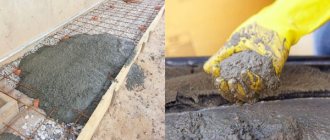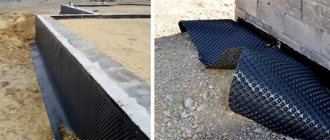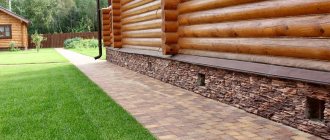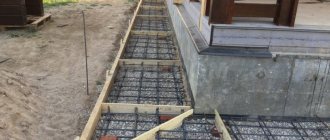Every home owner wants his home to last as long as possible and not need repairs. To do this, you need to do everything possible to prevent damage to the foundation under the influence of various factors. It is necessary to correctly calculate, take into account all the nuances, build the desired structure and drain water from it. In order to drain groundwater, it is worth installing a special drainage system. A high-quality blind area is considered an ideal option for water drainage.
High-quality water drainage
The price of a blind area made of crushed stone and gravel
The gravel blind area is similar in design to the foundation of a capital one, but without a hard top layer. Typically, the top layer is gravel, and the cost of soft reinforcement consists of excavation and backfilling with compaction of inert materials. Additionally, the cost may be affected by the installation of waterproofing pads and formwork. A preliminary calculation of the price for a blind area with crushed stone and gravel can be obtained from our specialists by calling the phone number listed on the website. An engineer visits the site to make an accurate calculation. He measures the perimeter and configuration of the house, after which an estimate is prepared and sent by email. Approximate prices for a blind area of at least 50 square meters. m around the house are shown in the table below:
| Name of works | Units | Price per sq. m, rub |
| Geodetic markings and elevation measurements | sq. m | 200 |
| Laying geotextiles | sq. m | 50 |
| Sand filling in a 10 cm layer with compaction | sq. m | 580 |
| Laying the Planter GEO membrane with fastening to the base of the house using Planter Profile | linear m | 650 |
| Filling of crushed stone with a layer of 10 cm with compaction | sq. m | 580 |
| Installation of plank formwork | linear m | 300 |
Calculate cost Order service
Faction selection
Fractions are the size of the pebbles resulting from crushing rocks. The higher the fraction, the larger the crushed stone. The price of such material for the blind area is lower than that of low-fraction crushed stone.
For the construction of blind areas, two types of fractions are used: small and medium.
Small crushed stone is easy to compact because its size does not exceed 2 cm. The average fraction includes pebbles from 2 to 4 cm. It looks great when poured around a house or other buildings.
The smallest crushed stone is used for road surfaces, while when larger ones are used, massive structures are built.
When choosing a stone for a blind area, you should rely on the following points:
1. Mixed crushed stone is the most affordable and more practical: it contains fractions from 0.5 to 4 cm. Advantages of this material:
- relatively low price;
- ensuring high quality drainage;
- Thanks to the content of assorted pebbles, it is easily compacted, so moving on it is not difficult.
2. Type of building for which a soft blind area is equipped. For example, the blind area around a well can be made of crushed gravel, while around multi-story buildings it is better to use granite crushed stone, which can withstand high loads.
IMPORTANT! When making a blind area around the house, it is necessary to build drainage systems. In this case, the blind area will have to be repaired much less frequently.
Drainage systems in the blind area of a house
Device technology using gravel and crushed stone
When constructing a gravel blind area, bedrock is excavated to a depth of 20–30 cm. After leveling the bottom of the trench, sand and crushed stone are poured layer-by-layer with compaction. An important element is the waterproofing membrane.
If there are no further plans to install other types of covering (tiles, concrete) on top of the crushed stone, then it is recommended to lay a Planter GEO type membrane between the layers of sand and crushed stone. Such waterproofing will stop and drain water from the house, which is the main purpose of the blind area.
If a blind area made of crushed stone is a temporary solution, and in the future a finishing coating is expected to be laid on top, then the membrane should not be used for two reasons:
1) excessive consumption of material. If concrete appears on top of the crushed stone, then the water will not reach the membrane, the membrane will be redundant. And together with the components, it is not cheap.
2) heaving of the coating. During periods of rising groundwater levels, water may accumulate under the membrane and create heaving zones. This is not critical for crushed stone; it will take its place after thawing. But if there is a hard coating, damage may occur in the finishing layer of concrete or tiles.
The technology for constructing a gravel blind area with crushed stone is as follows:
- preparing the foundation by removing soil to a depth of about 30 cm, a width of at least 60 cm and creating a slope of 2–3% in the direction from the building;
- laying geotextiles (optional);
- pouring a layer of sand 10–15 cm thick with compaction;
- installation of formwork;
- waterproofing device (if required);
- pouring crushed stone 15 cm thick with compaction and maintaining a given slope.
Order service
Materials required for construction
Before starting work, you must prepare all materials:
- The base is clay. You need fat plastic clay with a small amount of sand.
- You will need bitumen mastic and roll waterproofing. Modern material is based on fiberglass. It is better not to use prehistoric paper-based roofing felt.
- Thermal insulation material is extruded polystyrene foam 100 mm thick. Expanded polystyrene foam (made from white grains) is not suitable.
- Sand for drainage is coarse, with a fraction of 3-5 mm.
- Geotextile is a rolled non-woven water-permeable material. Density 100-150 g/m2.
- Crushed stone.
Device terms
Since the gravel blind area consists only of bulk materials, work on its installation can be carried out almost all year round. The only limitation will be laying the membrane during periods of negative temperatures: in the cold the plastic becomes very fragile! In winter, excavation work will also require the use of a hydraulic hammer or jackhammer to remove the top frozen layer of soil. The sand should be sifted, but not washed, as there will be blocks of ice in the latter!
The optimal time for constructing a blind area made of crushed stone and gravel is considered to be the period from April to November. With a non-rigid base area of up to 50 sq. m. construction requires no more than 3 working days. Laying a storm or drainage system can be done in parallel.
Primary requirements
The technical indicators of ready-made mixtures directly depend on the basic requirements for crushed stone.
- The average density of crushed stone grains should be 1.4-3 grams per 1 cm3.
- The compressive strength of the original rock is determined by the temporary resistance during clamping and grindability of the produced material.
- Flakiness. This is a parameter that characterizes the plane of crushed stone. In construction, plate-like forms of material that lack smoothness are practiced. Based on this, there are several types of stone categories. The cube-shaped shape is optimal, as it achieves excellent compaction.
- Fraction (grain size) of crushed stone for concrete. This parameter sets the dimensions of the material used.
- Frost resistance. This property will show in what temperature limits crushed stone can be used. For marking, the letter F is used, as well as a number indicating the cycles that crushed stone can withstand during freezing and thawing. Crushed stone marked F300 is endowed with optimal properties. This indicator must be adhered to in particular in the conditions of domestic construction, where the atmospheric temperature in summer and winter varies significantly.
- Radioactivity. This indicator indicates the natural radioactive background of the material. When class 1 is indicated on the package, it can be practiced in a variety of jobs. Class 2 is used for making road surfaces.
As already mentioned, the fraction affects the quality of concrete no less than the type of crushed stone. Its selection also depends on the intended work. For concrete mortar, crushed stone of a fraction of 5-70 millimeters is used. A finer distinction is formed by the subgroups 5-10 millimeters, 10-20 millimeters, 20-40 millimeters and 40-70 millimeters. For concreting, it is preferable to use larger fractions of gravel and crushed stone, since in this case the used filler will have a lower specific density and exert minimal pressure on the cement solution, which guarantees the necessary mobility of the concrete mixture.
According to SNiP 3.03.01-87, the concrete solution must contain in its structure crushed stone of at least 2 fractions with a maximum element size of up to 40 millimeters and at least 3 fractions when the largest components are equal to 40-70 millimeters. The largest size of crushed stone should be within less than a third of the smallest distance between the longitudinal reinforcement bars. Equally, it should not exceed 1/3 of the smallest size of a certain construction part, for example, its tape width.
The service life and reliability of concrete structures primarily depend not only on the extent to which high-quality materials are used, but also on how well the mixture is composed.
FAQ
With what type of foundation can a non-rigid blind area be made?
Answer
A gravel blind area can be used with any type of foundation (provided that waterproofing material such as Planter GEO is used).
Is it possible to lay tiles or pour concrete on the blind area next year?
Answer
This is possible, but such improvement must be taken into account at the gravel filling stage. In particular, you should not lay a membrane. You can get more detailed advice from our specialists by calling the numbers listed on the website.
Advice from professionals
- To prevent water from damaging the house and foundation, it is not enough to tilt only the upper part of the blind area. The liquid will gradually seep through the gravel and sand, so it is worth laying the waterproofing material also on a slope.
- The structure should fit as tightly as possible to the foundation so that there are no cracks into which water can get in. Frosts can have a negative impact on the condition of the structure. The trapped liquid freezes and can cause the blind area to begin to move away from the foundation.
- All calculations must be carried out correctly, down to the millimeter.
- All materials must be of good quality so that repairs are not required again soon.
If all the work is done correctly, this will provide not only reliable protection for the building, but also an attractive decorative element.
Manufacturing
A crushed stone structure is made according to the principle of a soft structure from clay, sand, roofing felt, geotextiles, and crushed stone mass.
The first layer is clay. They lay it 20 centimeters thick, sprinkle it with sand, and cover it with roofing material (geotextile, membrane). Afterwards, the layering alternates, crushed stone is poured on top.
The result is a solid but flexible structure that bends to the general condition of the soil, preventing the foundation from sagging.
The design with crushed stone can be diversified with artificial lawn, flower beds (under the windows, along the entire length of the house).
Layering
Comparison of technical indicators
The flakiness of the material is determined by the content of flattened and needle-shaped grains. Flaky (needle-like) is a granule whose length is three times greater than its width. If the length is approximately 3 times greater than the thickness, it is plate-type.
Crushed stone is divided into groups according to flakiness indicators:
- I – up to 10 percent needle-shaped and plate-shaped. Used in the production of reinforced concrete concrete and road surfaces.
- II improved group - 10 - 15 percent. A universal material for all construction operations, incl. blind areas.
- III middle group – 15-25%. Differs in quality characteristics and is not suitable for many jobs.
- IV is 25 35 percent. Used in glass making.
- Group V – 35 – 50%. The low quality of the material allows it to be used only in the construction of temporary objects.
Density and strength depend on the origin of the material. The higher the strength value, the more versatile the crushed stone. Density and strength have a proportional relationship.
Strength characterizes the ability of granules to withstand mechanical loads. Frost resistance is measured in the freezing and thawing cycles of the stone. The material must not lose its technical characteristics.
The table shows the comparative characteristics of crushed stone:
| Performance characteristics | Crushed stone | |||
| Granite | Gravel | Limestone | Slag | |
| Strength M, kgf/cm2 | from 1200 to 1400 | from 800 to 1000 | from 400 to 600 | from 300 to 600 |
| Frost resistance F, number of cycles | 350 | 300 | 150 | from 100 to 200 |
| Bulk density, kg/m3 | 1,39 | 1,32 | 1,29 | 1,25 |
| Flakiness, % | from 15 to 20 | from 20 to 25 | from 15 to 20 | from 20 to 25 |
| Radioactivity, Bq/kg | 300 | 70 | 55 | 95 |
Kinds
There are several types of crushed stone, each of which is made from a specific rock or mineral. They differ in their performance characteristics, hardness and density. The most popular options are worth considering in more detail.
Granite. This type of crushed stone is obtained from rock, which is considered to be the hardest and most durable. Crushed stone retains these properties, while it is frost-resistant and has a service life of up to 40 years. Granite crushed stone can have a fairly high background radiation
When choosing a material, it is important to pay attention to this indicator - permissible standards do not exceed 370 Bq/kg
All these types of crushed stone are available for purchase and use on the site when creating drainage
It is only important to choose the right option
Design Features
A blind area is a covering that tightly encircles a building along its entire perimeter. Has a specified continuous width. This structure is being constructed at the last construction stage, when the facing work on the foundation has already been completely completed.
Functions of the blind area:
- Protective function - when a large amount of precipitation falls, it falls into a special sewer for drainage, preventing contact of the foundation with water. If there is no blind area, water can eventually destroy the foundation of the entire house.
- Prevents swelling of the soil layer - the foundation structure will not be damaged if soil freezing is minimal.
- Thermal insulation ability helps retain heat at home, preventing the ground from freezing during the cold season.
- The decorative role enhances the appearance of the house, making it look finished and complete.











